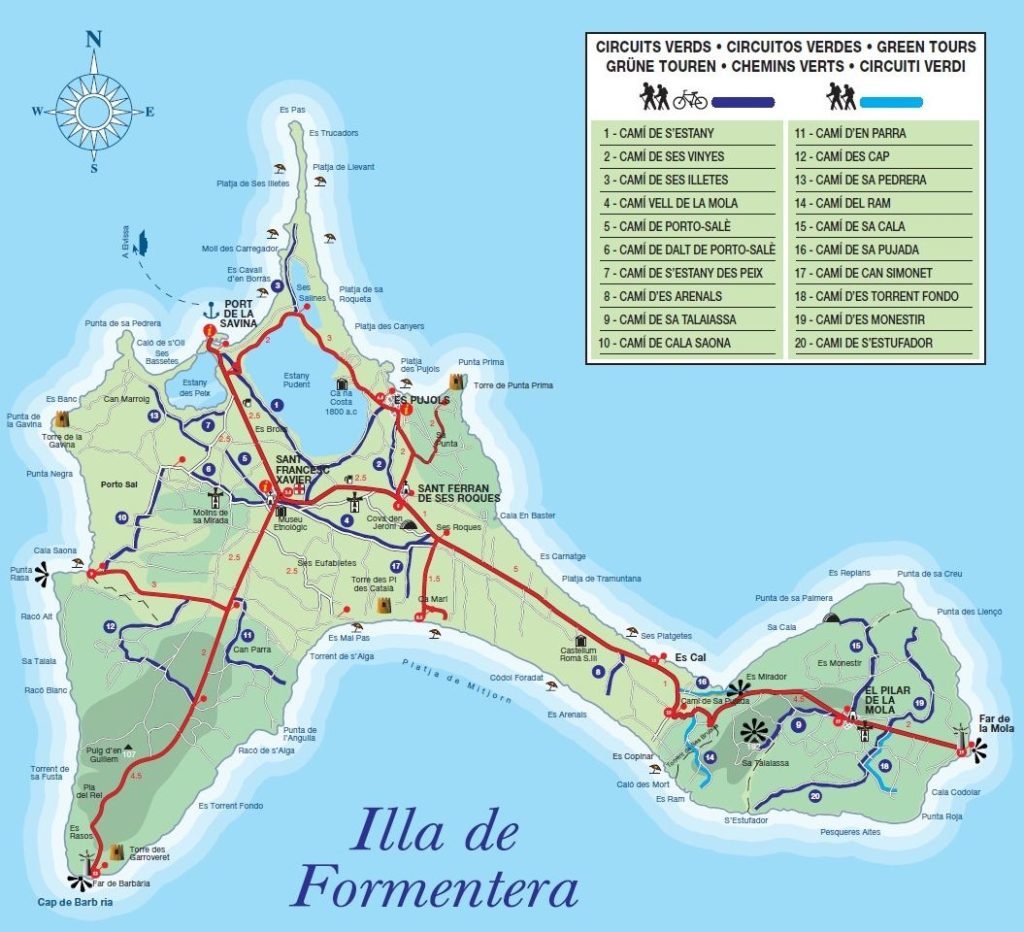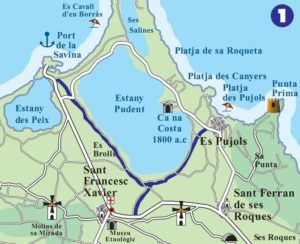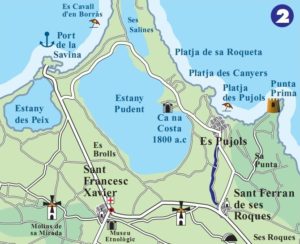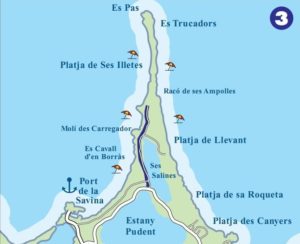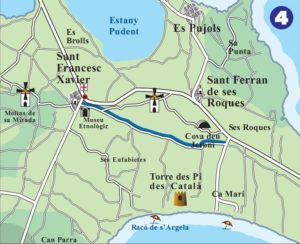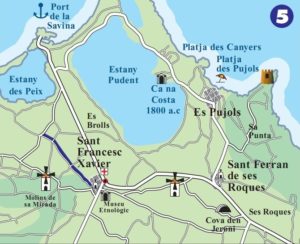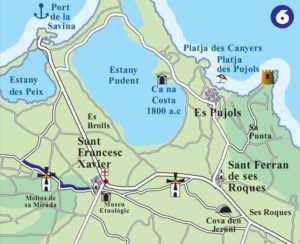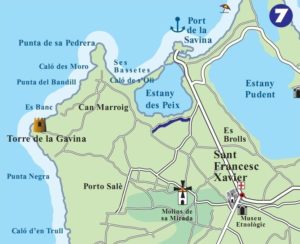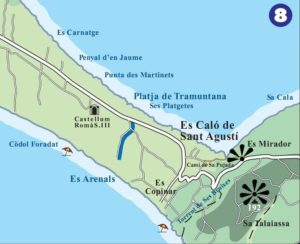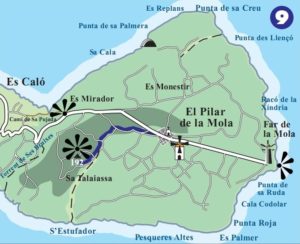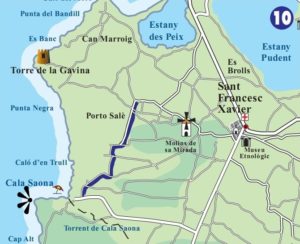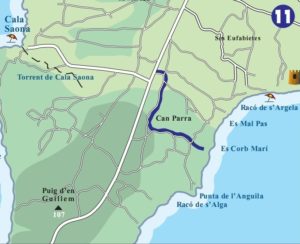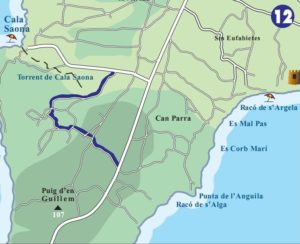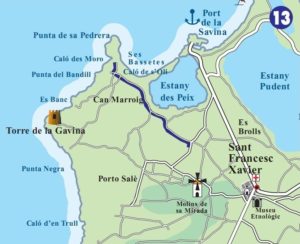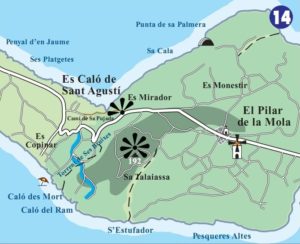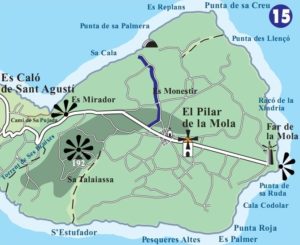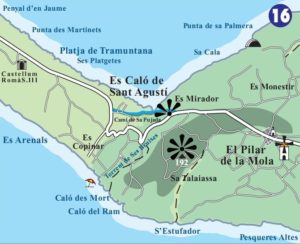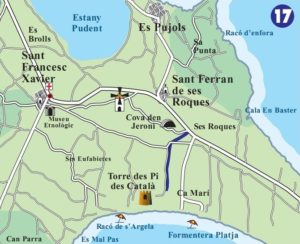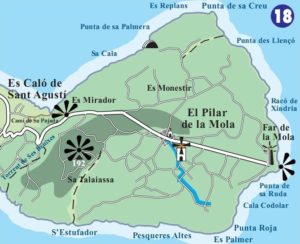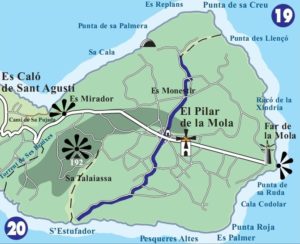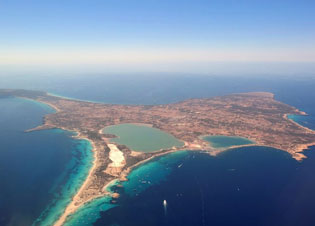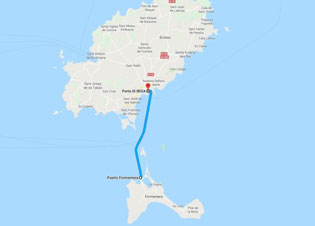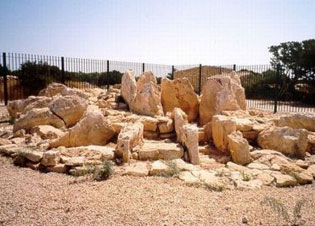
Formentera is an island full of green routes where you can stay in close contact with nature.
Formentera is such a beautiful island that it does not need any special frills to make itself fascinating. Its endemic beauty, given by its territory and its sea, has always made it a favorite destination for anyone looking for an authentic and uncontaminated place.
To experience it thoroughly and to come into close contact with nature, the municipality of Formentera has created a network of 20 green routes that will allow you to discover the island from multiple points of view. These are various routes scattered throughout the island, for a total of over 40 km; on foot or by bicycle, these paths will make you forget the wear and tear of modern life and a feeling of wellbeing will envelop your body and soul.
Most of these routes have been developed using old rural roads and are perfectly viable without the fear of getting lost; they are especially useful for those who want to follow alternative paths to the main roads.
Along these routes you will come across agricultural areas of vineyards, dunes and pine forests declared natural relief areas, panoramic views of the port of La Savina, suggestive coves and beaches, areas of architectural interest (you will see the “fincas”, the typical houses of the natives) and in general virgin areas without any settlement. Enveloped by the scents of nature and its magical aura you will understand why this island captures the heart of anyone who visits it.
Here in detail the 20 green routes of Formentera complete with description and map.
Camì de S’Estany: this route, about 4500 metres (or 2.8 miles) long, can be done on foot or by bicycle. Starting from the port of La Savina, go towards Es Pujols along the Estany Pudent, one of the two lakes (not suitable for bathing) in Formentera. This route is highly recommended for birdwatchers, as you can admire numerous species of birds such as gulls, ducks or the elegant flamingos. You will also walk along the now disused salt flats, which, before the advent of mass tourism, represented the most important activity on the island. Among the best things to see in Formentera, the pink colored salt marshes certainly can’t miss!
Shortly before arriving at the end of the route (which ends in the vibrant Es Pujols, the tourist centre par excellence) you can make a short detour to the left, towards Sant Francesc Xavier: here you can visit the dolmen of Ca Na Costa, one of the archaeological finds most important of Formentera.
Camì de Ses Vinyes: this very beautiful and suggestive route starts from Es Pujols and allows you to reach the village of Sant Ferran via an alternative path to the main road. You will pass through agricultural areas full of vineyards (from which the path takes its name) and you will come across a rural area rich in history. Just 1300 metres (or 0.8 miles) long, it allows visitors to admire centuries-old vineyards belonging to local families.
The wine tradition has a long history here on the island and the wine produced is of excellent quality: what makes these vineyards so special lies in their condition of “isolation”. When, in the last decades of the nineteenth century, the phylloxera appeared in the fields of all Europe, Formentera remained one of the few lands not contaminated by this deadly parasite; its being “island” therefore saved it. This is why Formentera wine is one of the finest products with an authentic and genuine taste.
Camì de Ses Illetes: it is located within the Natural Park of Ses Salines and leads to the most famous beaches of Formentera, including those of Ses Illetes, Platja de Llevant and Es Cavall d’en Borras. Along the famous salt flats, now disused, you will cross dunes and pine forests of extraordinary beauty. This is certainly not to be missed among the island’s numerous green routes. Along only 1900 metres (or almost 1.2 miles), it contains one of the most evocative stretches of the whole island.
Camì Vell de la Mola: for this route, 3000 metres (about 1.85 miles) long, the use of the bicycle is recommended. It is a paved road that connects Sant Ferran to the area of Ca Marì (it is the western area of Playa de Migjorn). It is located in a very quiet area of the island, among fields and characteristic vegetation, you will be immersed in the most authentic Mediterranean scrub; on the way you will also be able to see an old mill, namely the Molì d’en Tauet. Through this itinerary you will observe how life flows placidly in the hinterland of this magnificent island.
Camì de Dalt de Porto-Salè: is the paved road that joins Sant Francesc Xavier with the road that goes to Porto Salè. This circuit has the advantage of having wonderful views in all directions of the island. Also along the way you will meet another mill, the Molì de Sa Mirada. 2500 metres (about 1.55 miles) long it can be covered both on foot and by bicycle.
Camì de S’Estany des Peix: this route runs along the Estany des Peix, a small saltwater lagoon. It is often mistaken for a lake but it is a sea water inlet with a narrow and shallow opening towards the sea. Belonging to the Natural Park of Ses Salines, this short route of just 800 metres (or 0.5 miles) offers panoramic views of the port of La Savina. It is passable both on foot and by bicycle.
Camì d’Es Arenals: this route, which starts at the fork in the main road connecting La Savina to El Pilar de La Mola, reaches the beach of Es Arenals (it is the eastern area of Playa de Migjorn), one of the most beautiful in Formentera. Crossing a beautiful area of pine forests and dunes you will literally be enveloped by the intense aromas of the surrounding vegetation. It is one of the shortest green routes, only 1000 metres (about 0.6 miles) long, and can be traveled on foot or by bicycle.
Camì de Sa Talaiassa: connects the small town of El Pilar de la Mola with the highest point of the island. This route passes through an agricultural area of great beauty where you can observe the numerous dry-stone walls (iconic element of the rural architecture of the island) and several “fincas”, the typical houses of Formentera, with thick walls able to isolate from the high summer temperatures and to conserve heat during mild winters. 2000 metres (about 1.25 miles) long, it can be done on foot or by bicycle even if the last stretch can be covered only on foot.
Camì de Cala Saona: connects Porto Salè with the magnificent Cala Saona beach, the only one in Formentera to be situated in a cove. You pass through a large rural area. It is 2500 metres (or 1.55 miles) long and you can go either on foot or by bicycle.
Camì d’en Parra: route that begins at the bifurcation of the main road leading to Cap de Barbaria and which crosses the area known as Can Parra, one of the areas of Formentera where popular architecture is best preserved. On this path it is possible to discover the most intimate and ancient part of the island with the typical stone houses hidden among the pine woods. 2300 metres (almost 1.5 miles) long, the first section is asphalted and it is possible to cover it on foot or by bicycle.
Camì des Cap: connects the road that leads to Cala Saona with the road to Cap de Barbaria and alternates paved parts with dirt parts. You will pass through a rural area with interesting panoramic views of Cala Saona, Sant Francesc and La Mola. 3000 metres (about 1.85 miles) long and passable on foot or by bicycle.
Camì de Sa Pedrera: is the path that leads to Punta de Sa Pedrera and has magnificent views of Estany des Peix and Can Marroig as well as panoramic views of the island of Ibiza and the islet of Es Vedrà. It is 2200 metres (about 1.35 miles) long and can be traveled on foot or by bicycle.
Camì del Ram: this path starts at the beginning of the climb towards La Mola and leads to Es Ram (near Calò Des Mort). At the end of the path it is possible to observe the wonderful panorama overlooking the surrounding area. It is 1300 metres (or 0.8 miles) long and can only be traveled on foot.
Camì de Sa Cala: connects El Pilar de la Mola with Sa Cala, an area of high archaeological value formed by nine sites scattered over the surrounding lands. Once you reach your destination, you can admire a magnificent panorama of the entire island. 2000 metres (about 1.25 miles) long and passable on foot or by bicycle.
Camì de Sa Pujada: this path is also called Camino Romano. This route connects the small town of Es Calò with Es Mirador, a very high point where it is possible to have a breathtaking view of the island. The story tells that this was the ancient ascent route used to reach La Mola. Its name derives from the fact that the cobblestone in some parts of the path is reminiscent of the historic pavement of the Ancient Appian Way in Rome.
The route allows you to penetrate the dense vegetation and here, as never before, you will be in close contact with nature. 1500 metres (about 0.9 miles) long it can be explored only on foot. Among the various green routes of Formentera it is probably one of the most loved and popular.
Camì de Can Simonet: this route leads to one of the most remote corners of the wide Migjorn beach, precisely in the Ca Marì area. Starting from Sant Ferran you will arrive at the Pi des Català tower, one of the 5 defensive towers present in Formentera.
1800 metres (or 1.1 miles) long, passable on foot or by bicycle, it offers not only splendid views over the entire south coast of the island, but there is also the possibility of visiting the tower (every Saturday from 10 am to 1 pm) recently restored by the architect Maria Castello Martinez.
Camì d’es Torrent Fondo: this path starts from the road that leads to the lighthouse of La Mola and passes near the Molì Vell, an ancient windmill. At the end of the 2500 metre walk, you will reach the cliff on the southern part of the island, in the area of Punta Roja. It is accessible only on foot.
Camì de S’Estufador: this path is the last of the 20 green routes of Formentera. It connects the village of La Mola with the area of S’Estufador, reaching up to the south cliff of Formentera. Passing by some windmills, along the way you will come across a pine forest and near the sea you will be able to admire the characteristic fishermen’s huts: the particular wooden constructions that were used and still serve now to preserve their own boat, thanks also to the rudimentary but highly efficient rails that facilitate the entry and exit of the vehicle. 3000 metres (about 1.85 miles) long and it is possible to go there only on foot.
YOU MAY ALSO LIKE:
“Every trip you live three times:
when you dream it,
when you live it
and when you remember it. “
PROMOTIONAL CODE
Book online using the promotional code ESTATE123 and save with our partners. The code is valid for EVERYONE. You can take advantage of the discounts even if we were unable to provide the right accommodation for you.


